flat tire AUDI S8 2011 User Guide
[x] Cancel search | Manufacturer: AUDI, Model Year: 2011, Model line: S8, Model: AUDI S8 2011Pages: 302, PDF Size: 76.07 MB
Page 246 of 302
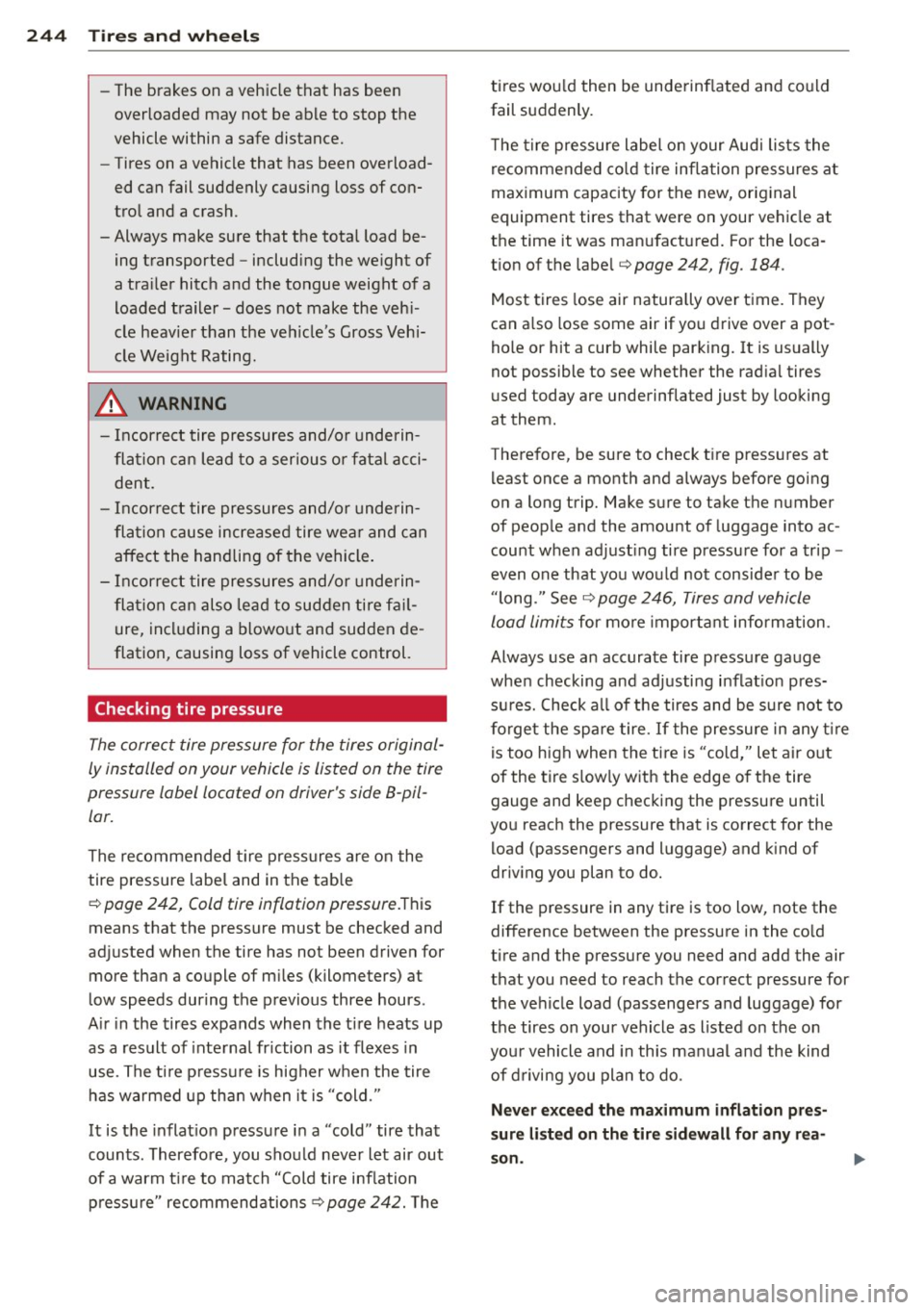
24 4 T ir es and whe els
- The brakes on a vehicle that has been
overloaded may not be able to stop the
vehicle within a safe distance.
- Tires on a vehicle that has been overload
ed can fail suddenly causing loss of con
trol and a crash.
- Always make sure that the tota l load be
ing transported -including the we ight of
a trailer hitch and the tongue weight of a
loaded trailer - does not make the veh i
cle heav ier than the veh icle's Gross Vehi
cle Weight Rating.
A WARNING
- Incorrect tire pressures and/or underin
flation can lead to a serious or fatal acci
dent.
- Incorrect tire pressures and/or underin
flation cause increased tire wear and can affect the handling of the vehicle .
- Incorrect tire pressures and/or underin
flation can also lead to sudden tire fa il
ure, including a blowo ut and sudden de
flation, causing loss of vehicle control.
Checking tire pressure
.
The correct tire pressure for the tires original
ly installed on your vehicle is listed on the tire
pressure label located on driver's side 8-pil
lar.
The recommended t ire pressures are on the
tire pressure labe l and in the tab le
r::;, page 242, Cold tire inflation pressure.This
means that the pressure must be checked and
adjusted when the tire has not been driven for
more than a couple of m iles (kilometers) at
low speeds during the previous three hours .
A ir in the tires expands when the tire heats up
as a result of internal fr iction as it flexes in
use. The ti re p ressu re is higher w hen the tire
has warmed up than when it is "cold ."
It is the inflat ion pressure in a "cold" tire that
counts. Therefo re, you shou ld never let air out
of a warm t ire to match "Cold tire inflation
p ressure" recommendations
¢page 242. T he tires wou
ld then be unde rinf lated and co uld
fail suddenly.
T he tire pressure label on your Audi lists the
re commended co ld tire inflation pressures at
maximum capacity for the new, original
equipment tires that were on your vehicle at
t h e time it was man ufactured. For the loca
t ion of the labe l
r::;, page 242, fig. 184 .
Most tires lose air natura lly over time. They
can a lso lose some air if you drive over a pot
ho le or hit a curb while park ing. It is usually
not possible to see whether the rad ia l tires
used today are underinflated just by looking
at them .
Therefore, be sure to check t ire press ures at
l east once a month and a lways before going
on a long trip. Make sure to take the number
of peop le and the amount of luggage into ac
count when adjust ing tire pressure for a trip -
even one that you wo uld not consider to be
"long." See
r::;, page 246, Tires and vehicle
load limits
for more important information .
Always use an accurate ti re pressu re gauge
when checking and ad justing inflat ion pres
su res. Check all of the tires and be sure not to
forget the spare tire.
If the pressure in any t ire
is too high when the ti re is "cold," let air o ut
of the ti re s low ly with the edge o f the tire
gauge and keep checking the pressure until
you reach the pressure that is correct for the load (passengers and luggage) and k ind of
driv ing you plan to do.
If the pressure in any tire is too low, note the
difference between the pressure in the co ld
tire and the pressure you need and add the air
that you need to reach the correct pressure for
the ve hicle load (passengers and luggage) for
the tires on your vehicle as listed on the o n
your vehicle and in th is manual and the kind
of d riving you plan to do .
Never e xce ed the max imum inflation pres
sure list ed on the tire sidewall for any rea
s on .
Page 247 of 302
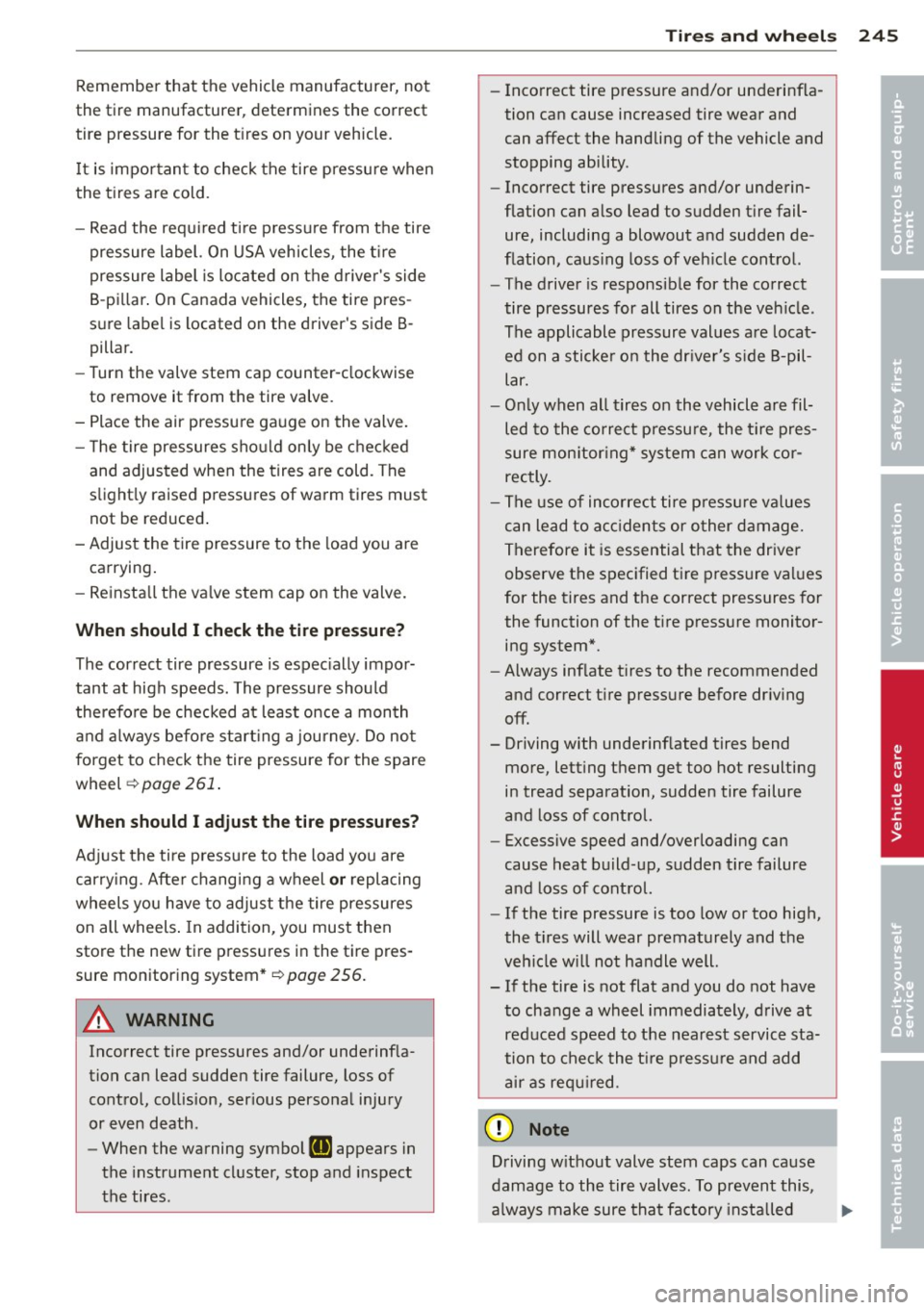
Remember that the vehicle manufacturer, not
the tire manufacturer, determines the correct
tire pressure for the t ires on your vehicle.
It is impor tan t to check the tire pressu re when
the t ires a re cold .
- Read the requ ired ti re p ressure from the tire
pressure label. On USA veh icles, the t ire
pressure label is located on the drive r's side
B-pi llar . On Canada vehicles, the tire pres
sure label is located on the driver's side B
pillar.
- Turn the valve stem cap counter-clockwise
to remove it from the tire valve.
- Place the air pressure ga uge on the valve.
- T he tire pressures sho uld only be chec ked
and adjusted when the t ires are cold. The
s li ght ly raised pressures of warm tires must
not be reduced .
- Adjust the tire pressure to the load you are
ca rrying .
- Re insta ll the va lve stem cap on the valve.
When should I ch eck the tire pressur e?
The cor rect tire pressure is espec ially impor
tant at high speeds. The pressure should
therefo re be checked at least once a month
a nd a lways before start ing a journey. Do no t
forget to check the tire pressure for the spare
wheel
r:!> page 261 .
When should I adjust the tire pressures ?
Adjust the tire p ressure to the load you are
carry ing. Afte r changing a wheel
or replacing
wheels you have to adjust the tire pressures
on all wheels . In addition, you must then
store the new tire pressures i n the tire pres
sure monitoring system *
r:!> page 256.
A WARNING
Incorrect tire pressures and/or underinfla
tion can lead sudden tire failure, loss of contro l, col lision, ser ious persona l injury
or even death.
- When the warning symbo l
[I] appears in
the instrument cluster, stop and inspect
the tires .
Tires an d wheel s 245
-Inco rrect tire pressure and/or underinfla
tion can cause increased tire wear and
can affect the handli ng of the vehicle and
stopping ability .
- Incorrect tire pressures and/or underin
flation can a lso lead to sudden t ire fail
ure, including a blowout and sudden de
flation, caus ing loss of veh icle cont rol.
- The drive r is responsib le for the correct
tire pressures for all tires on the ve hicle.
The appli cable pressure values a re locat
ed on a sticke r o n the dr iver's s ide B -pil
lar.
- Onl y when all tir es on the vehicle are fil
led to the co rrect p ressu re, the t ire pres
sure mon itor ing* syste m can work cor
rectly.
- Th e use of incorrect tire p ress ure v alues
can lead to a cciden ts or o ther d amage.
T herefore it is essential that the drive r
observe the specified tire press ure va lues
for the tires and the correct pressures for
the function of the t i re p ress ure monito r
ing system*.
- Always inflate t ires to the recommended
and correct t ire pressure before dr iv ing
off.
- Driving with underinf lated tires bend
more, lett ing them get too hot resulting
in tread separation, sudden tire failure
a nd loss of cont rol.
- Excessive speed and/overloading can
cause heat build- up, sudden tire failure
a nd loss of cont rol.
- If the tire pressure is too low or too high,
the t ires will wear prematurely and the
veh icle w ill not handle well.
- If the tire is not flat and you do not have to change a wheel immediately, d rive at
red uced speed to t he nearest servic e sta
tion to che ck the t ire p ress ure and add
air as req uired.
0 Note
Driving w ithout valve stem caps can cause
damage to the tire valves. To prevent this,
a lways make sure that factory insta lled
•
•
Page 248 of 302
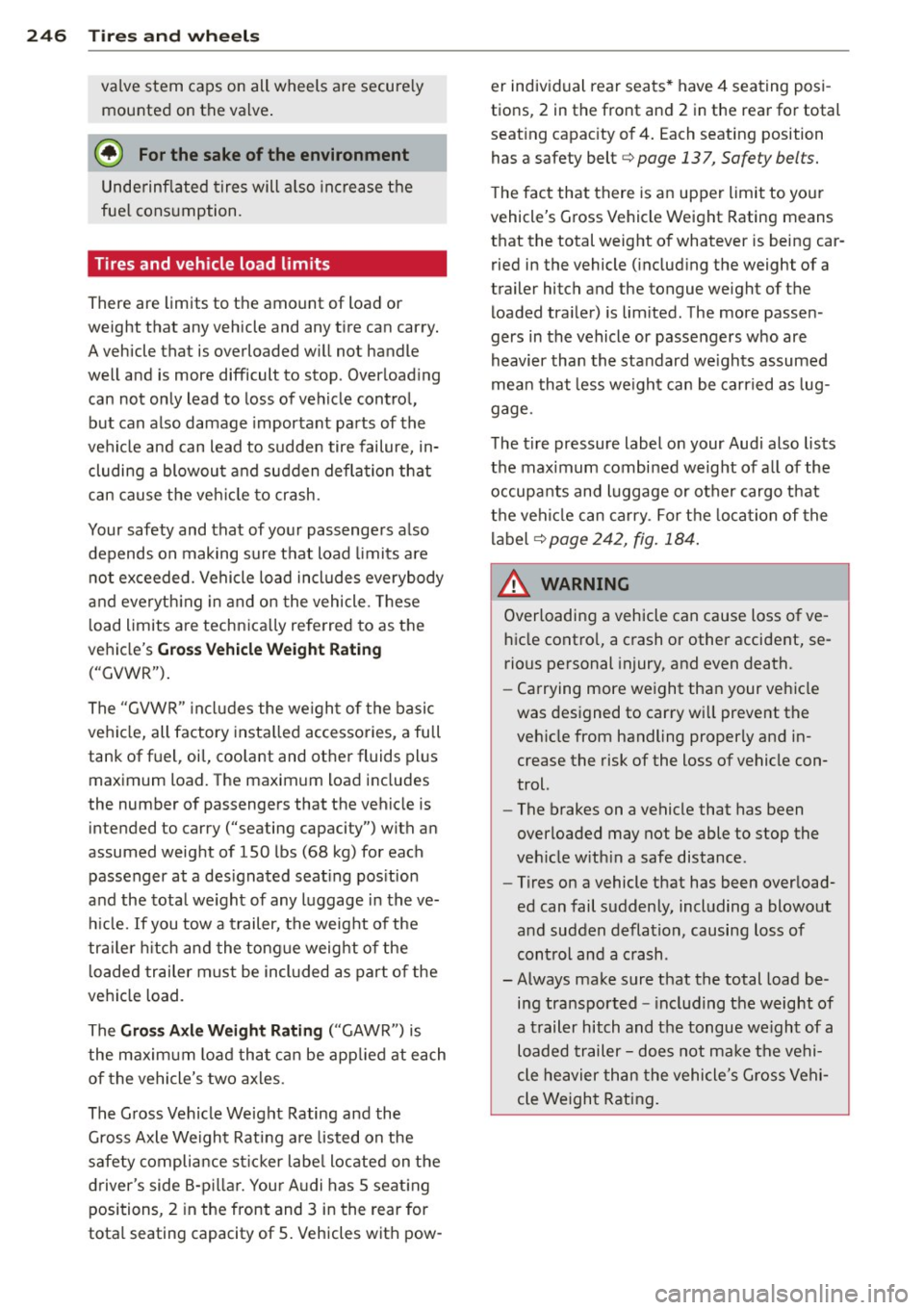
246 Tires and wheels
valve stem caps on all wheels are secure ly
mounted on the valve .
@ For the sake of the environment
Underinflated tires will also increase the
fue l consumption.
Tires and vehicle load limits
There are limits to the amount of load or
weight that any vehicle and any tire can carry.
A vehicle that is overloaded will not handle
well and is more difficult to stop. Overloading
can not only lead to loss of vehicle control, but can also damage important parts of the
vehicle and can lead to sudden tire failure, in
cluding a blowout and sudden deflation that
can cause the vehicle to crash.
Your safety and that of your passengers also
depends on making sure that load limits are
not exceeded. Vehicle load includes everybody
and everyth ing in and on the vehicle. These
l oad limits are techn ica lly referred to as the
vehicle's
Gross Vehicle Weight Rating
("GVWR").
The "GVWR" includes the we ight of the basic
vehicle, all factory installed accessories, a full
tank of fuel , oil, coo lant and other fluids plus
maximum load. The maximum load includes
the number of passengers that the vehicle is
intended to carry ("seating capacity") with an
assumed weight of 150 lbs (68 kg) for each
passenger at a des ignated seat ing pos ition
and the tota l we ight of any luggage in the ve
hicle. If you tow a trailer, the weight of the
trailer hitch and the tongue weight of the
l oaded trailer must be included as part of the
vehicle load.
The
Gross Axle Weight Rating ("GAWR") is
the maximum load that can be applied at each
of the vehicle's two axles.
The G ross Vehicle Weight Rating and the
Gross Axle Weight Rating are listed on the
safety compliance sticker labe l located on the
driver's side B-p illar. You r A udi has 5 seat ing
positions, 2 in the front and 3 in the rear for
total seating capacity of 5. Vehicles with pow- er individual rear seats* have
4 seating posi
tions,
2 in the front and 2 in the rear for total
seat ing capac ity of
4. Each seating position
has a safety belt¢
page 137, Safety belts.
The fact that there is an upper limit to your
vehicle's Gross Vehicle Weight Rating means
that the total weight of whatever is being car
ried in the vehicle (including the weight of a
trailer hitch and the tongue weight of the
loaded trailer) is lim ited . The more passen
gers in the vehicle or passengers who are
heavier than the standard we ights assumed
mean that less we ight can be carried as lug
gage.
The tire pressure label on your Audi also lists
the max imum combined weight of a ll of the
occupants and luggage or other cargo that
the vehicle can carry. For the location of the
label¢
page 242, fig. 184.
A WARNING ,___
Overloading a vehicle can cause loss of ve
h icl e contro l, a crash or other accident, se
rious personal injury, and even death.
- Carrying more weight than your vehicle
was designed to carry will prevent the
vehicle from handling properly and in
crease the risk of the loss of vehicle con
trol.
- The brakes on a vehicle that has been
overloaded may not be able to stop the
veh icle with in a safe distance.
- Tires on a vehicle that has been overload
ed can fail suddenly, including a blowout
and sudden deflation, causing loss of
control and a crash.
- Always make sure that the total load be
ing transported -including the weight of
a trailer hitch and the tongue we ight of a
loaded trailer -does not make the vehi
cle heavier than the vehicle's G ross Vehi
cle Weight Rating.
Page 249 of 302
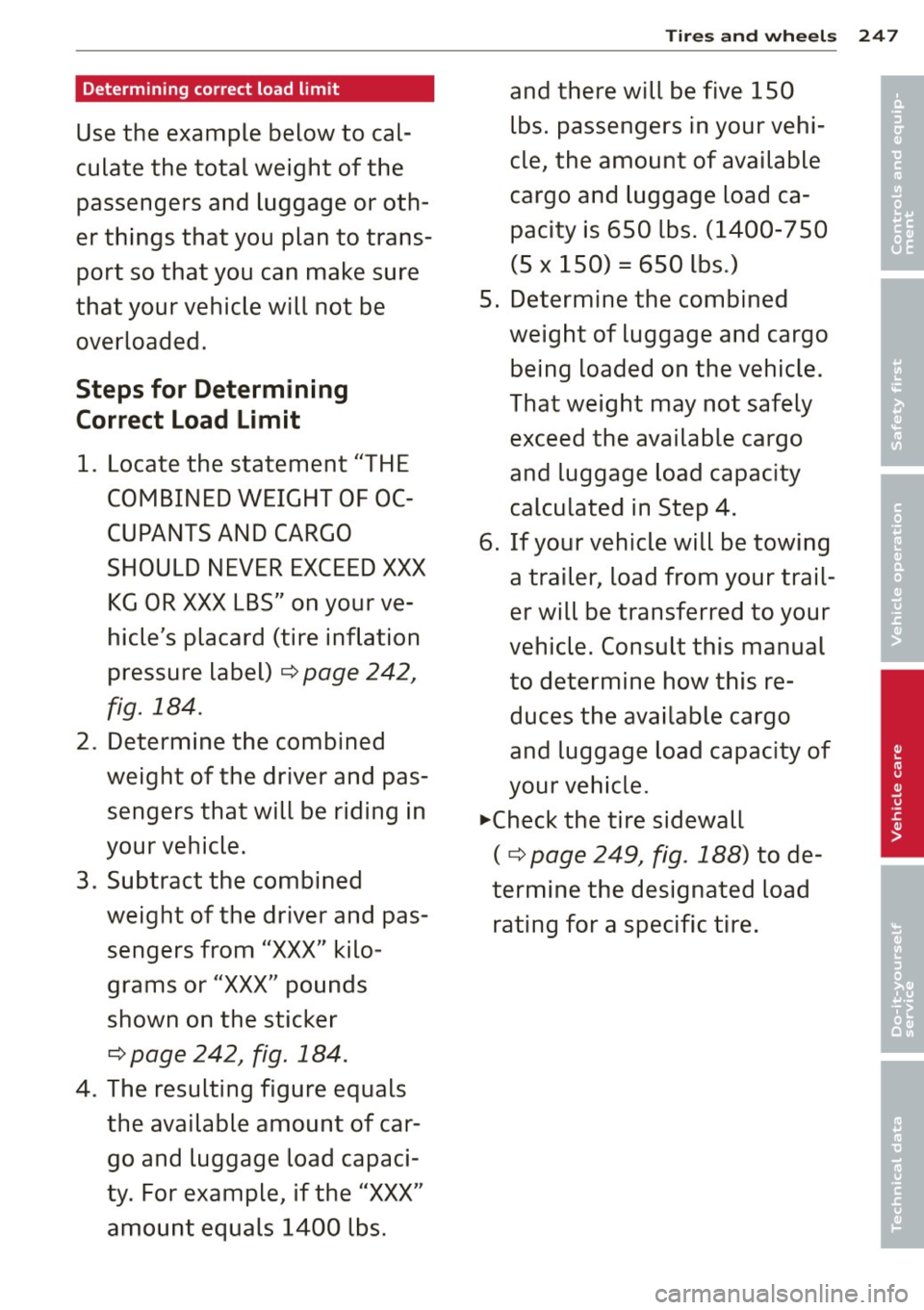
Determining correct load limit
Use the example below to cal
culate the total weight of the
passengers and luggage or oth
er things that you plan to trans
port so that you can make sure
that your vehicle will not be overloaded.
Steps for Determining
Correct Load Limit
1. Locate the statement "THE
COMBINED WEIGHT OF OC
CUPANTS AND CARGO
SHOULD NEVER EXCEED XXX KG OR XXX LBS" on your ve
hicle's placard (tire inflation
pressure label)
¢ page 242,
fig. 184.
2. Determine the combined
weight of the driver and pas
sengers that will be riding in
your vehicle.
3. Subtract the combined
weight of the driver and pas sengers from
"XXX" kilo
grams or
"XXX" pounds
shown on the sticker
¢ page 242, fig. 184.
4. The resulting figure equals
the available amount of car
go and luggage load capaci
ty. For example, if the
"XXX"
amount equals 1400 lbs.
Tires and wheels
and there will be five 150
lbs. passengers in your vehi
cle, the amount of available
cargo and luggage load ca pacity is 650 lbs. (1400-7 50
(5
X 150) = 650 lbs.)
5. Determine the combined
weight of luggage and cargo
being loaded on the vehicle.
That weight may not safely exceed the available cargo
and luggage load capacity
calcu lated in Step
4.
6. If your vehicle will be towing
a trailer, load from your trail
er will be transferred to your
vehicle. Consult this manual
to determine how this re
duces the available cargo
and luggage load capacity of
your vehicle.
,...Check the tire sidewall
(¢page 249, fig. 188) to de
termine the designated load rating for a specific tire.
247
•
• '
Page 251 of 302
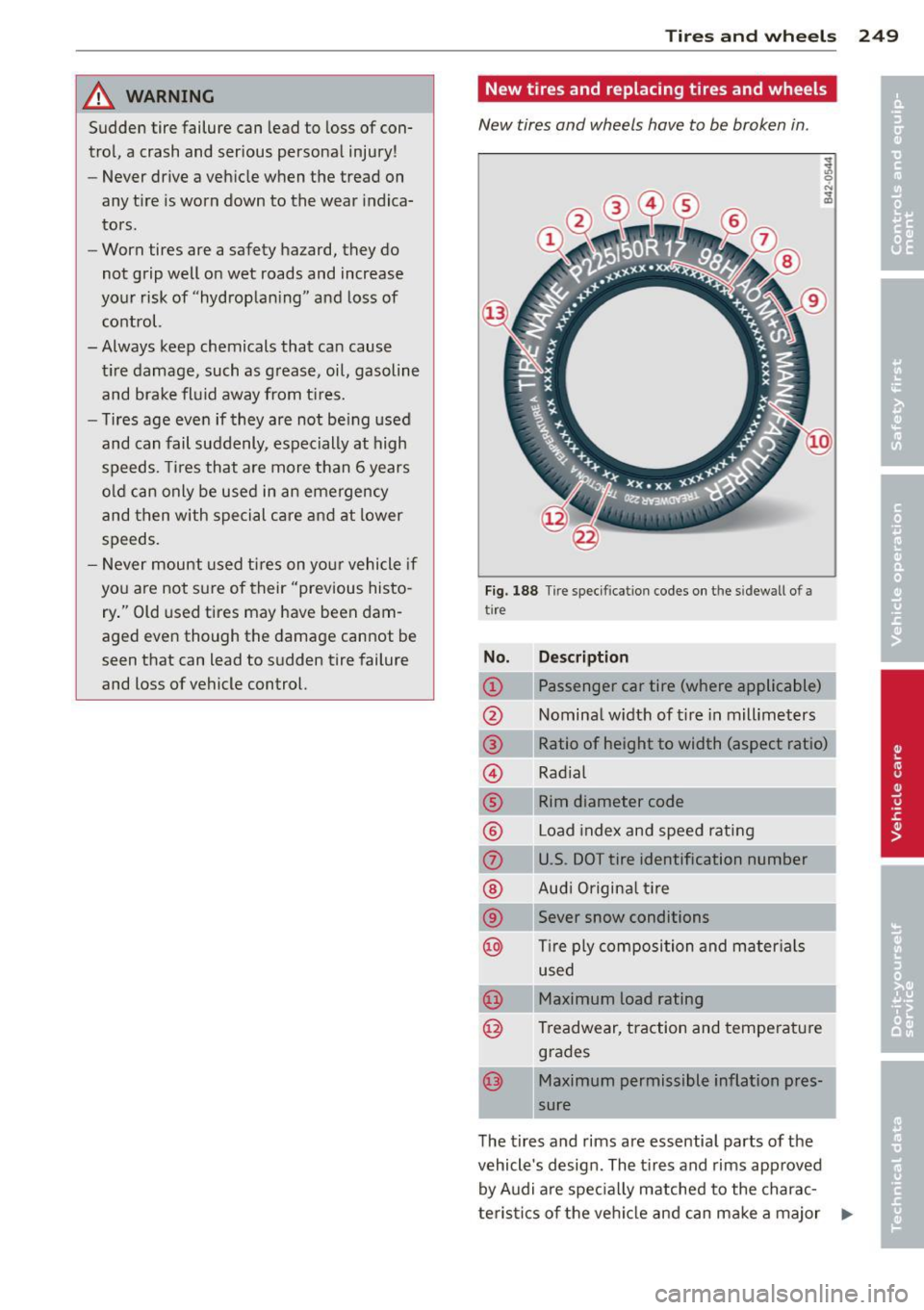
A WARNING
Sudden tire failure can lead to loss of con
trol, a crash and serious personal injury!
- Never drive a vehicle when the tread on
any tire is worn down to the wear indica
tors.
- Worn tires are a safety hazard, they do
not grip well on wet roads and increase
your risk of "hydroplaning" and loss of
control.
- Always keep chemicals that can cause
tire damage, such as grease, oil, gasoline
and brake fluid away from t ires.
- Tires age even if they are not be ing used
and can fail suddenly, especially at high
speeds . Tir es that are more than 6 years
old can only be used in an emergency
and then with special care and at lower
speeds.
- Never mount used tires on your vehicle if
you are not sure of their" previous histo
ry ." Old used tires may have been dam
aged even though the damage cannot be
seen that can lead to sudden tire failure
and loss of vehicle control.
Tires and wheels 249
New tires and replacing tires and wheels
New tires and wheels have to be broken in .
Fig. 188 Tir e specificat ion codes on t he s idewall o f a
tire
No. Description
CD Passenger car tire (where applicable)
@ Nominal w idth of tire in millimeters
® Ratio of height to width (aspect ratio)
© Radial
® Rim diameter code
® Load index and speed rating
(f) U.S. DOT tire identification number
® Audi Origina l tire
® Sever snow conditions
@ T ire ply composition and materials
used
@ Maximum load rating
@ Treadwear, traction and temperature
grades
@ Maximum permissible inflation pres-
sure
The tires and rims are essential parts of the
vehicle's design . The tires and rims approved
by Audi are spec ially matched to the charac
teristics of the vehicle and can make a major .,.
•
Page 252 of 302

250 Tires and wheels
contribution to good road ho lding and safe
handling when in good condition and properly
inflated
¢ ,& .
We recommend that all work on tires and
wheels be performed by an authorized Audi
dealer. They are familiar with recommended
procedures and have the necessary spec ial
too ls and spare parts as well as the proper fa
cilities for disposing of the old tires.
Authorized Audi dealers have the necessary information about technical requ irements for
installing or changing tires and r ims.
Replacing tires and wheels
Tires shou ld be rep laced at least in pairs and
not individually (for example both front tires
or both rear tires together).
Be sure to read and heed the information to
the tire pressure monitoring system*
¢page 256.
Always buy rep lacement radial tires that have
the same specifications as the tires approved
for your vehicle by Audi. Replacement tires
must always have the same load rating speci
fication as the original equipment or approved optional tires listed in the table
¢page 242.
Audi-approved specification t ires are specially
matched to your vehicle and its load limits,
and can contribute to the important road hold
ing, driving characteristics, and safety of the
vehicle. The table(¢
page 242) lists specifica
tions of the tires approved for the Audi mod
els covered by your Owner's Literature .
The tire pressure label located on driver's side
B-pillar (
¢ page 242, fig. 185) lists the speci
fications of the orig inal equipment tires in
stalled on your veh icle at the time it was man
ufactured.
Federal law requires tir e manufacturers to
place standard ized information on the s ide
wall of all tires¢
fig. 188 . This information
identifies and describes the fundamental
characterist ics, the quality grade of the tire
and also provides a tire ident ificat ion number for
safety standard ce rtification and in case of
a reca ll.
Tire specifications
Knowledge of tire specificat ions makes it eas
ier to choose the correct tires. Radial tires
have the tire specifications marked on the
sidewa ll, for examp le:
255/45 R 19 104 H
This conta ins the following information:
P Indicates the t ire is for passenger cars
(where app licab le)
255 Nominal tire width in mm of the tire
from sidewall edge to sidewa ll edge. In
general, the larger the number, the wider
the tire
45 Height/w idth ratio in percent (aspect ra-
t io)
R Tire construction: Radial
19 Rim diameter code (in inches)
104 Loa d rating code
H Speed rat ing letter code
XL (or "xl", "EXTRA LOAD" or "RF") indicates
that the tir e is a "Reinforced" or an "Ext ra
Load" tire
M+S (or "M/S") Indicates that the tire has
some mud and snow capability
The tires could also have the information of
direction of rotation¢
page 238 .
Tire manufacturing date
The manufacturing date is also indicated on
the tire sidewall (possibly on ly on the
inner
side of the wheel):
"DOT ... 2211. .. " means, for example, the tire
was produced in the 22nd week of 2011.
Speed rating (letter code)
The speed rating letter code on the whee ls in
dicates the maximum permissible road speeds
¢ .&. in Winter tires on page 254.
P up to 93 mph (150 km/h)
Q up to 99 mph (158 km/h)
R up to 106 mph (170 km/h)
S up to 110 mph (180 km/h)
Page 253 of 302

T up to 118 mph (190 km/h)
U up to 124 mph (200 km/ h)
H up to 130 mph (210 km/ h)
V up to 149 mph (240 km/h)1
)
Z over 149 mph (240 km/h)l)
W up to 168 mph (270 km/h)l)
Y up to 186 mph (298 km/h)l)
Your veh icle is no rma lly factory equipped with
tires , which possess excellent driving charac
teristics and give your Audi opt imum driving
comfort . An e lectronic speed limiter
c::> page 28 wi ll normally prevent you r vehicle
from go ing fa ster th an the tire speed ra ting
c:::> .& .
U.S . DOT T ire Identificat ion Numb er (TIN )
and tire manufacture date
This is the t ire's "se rial number" . It begins
wi th the letters "DOT" and indicates that the
tire meets all federal standards . The next two
numbers or letters indicate the plant where it
was manufactured, and the last four numbers r epresent the week and year of manufacture.
F or
examp le, the numbers 22 10 mean the ti re
was prod uced in the 22nd week of 2010. The
other numbers are marketing codes that may
or may not b e used by the tire manufacturer .
T his information is used to contact consumers
i f a t ire defect requires a reca ll.
Aud i original tir e
Tires with t he identification "AO" or "RO" have
been specia lly matched w ith your Audi . We
recommend using only these tires because
they meet the highest standards regard ing
sa fety and driving character istics when used
correctly . Your authorized Audi dealer will
gladly provide you with more information .
Tire ply compo sit ion and materi als used
The number of plies indicates the number of
layers of rubber-coated fabric in the t ire. In
general, the greater the number of plies, the more weight a tire can support. Tire manufac -
llFt· "h · or ires wit a m ax im um spee d cap abil ity over 149
mph (2 4 0 k m/h) , tire man ufacturers some times u se
th e le tters "Z R."
Tire s an d wheel s 251
ture rs also must indicate the mate rials in the
tire , which include stee l, nylon , po lyester, and
others .
Maximum Load Rating
This number ind icates the maximum load in
k ilograms and po unds that can be ca rr ied by
the tire.
Tire quality grading for treadwear ,
traction, and t emp eratur e resistanc e
Tre ad wear, t raction and tempera ture grades
c::> page 2 52 .
Maximum Permissible Inflation Pressure
This number is the greatest amount of a ir
pressure that should ever be put in the t ire
u nder norma l dr iv ing cond itions .
_&. WARNING ,-=
-Using incorrect o r unmatched tires and/
or wheels or improper tire and wheel
comb inations can lead to loss of control
'
coll is ion and serious personal inj ury.
- Always use tires, rims and whee l bolts
that meet the specifications of original
factory- insta lled tires or other combina
tions that have been specifically ap proved by the vehicle manufacturer.
- Tires age even if they are not being used
and can fail suddenly , especially at high
speeds . Tires that are more than 6 years
old can only be used in an emergency
and then w ith special care and at lower
speeds.
- Never mo unt used tires on your veh icle if
you are not sure of thei r "previous histo
ry." O ld used tir es may have been dam
aged even though the damage cannot be
seen that can lead to sudden tire fai lure
and loss of vehicle control.
- All four whee ls must be fitted with radial
tires of the same type, size (rolling cir
cumference) and the same tread pattern .
~
•
•
Page 254 of 302
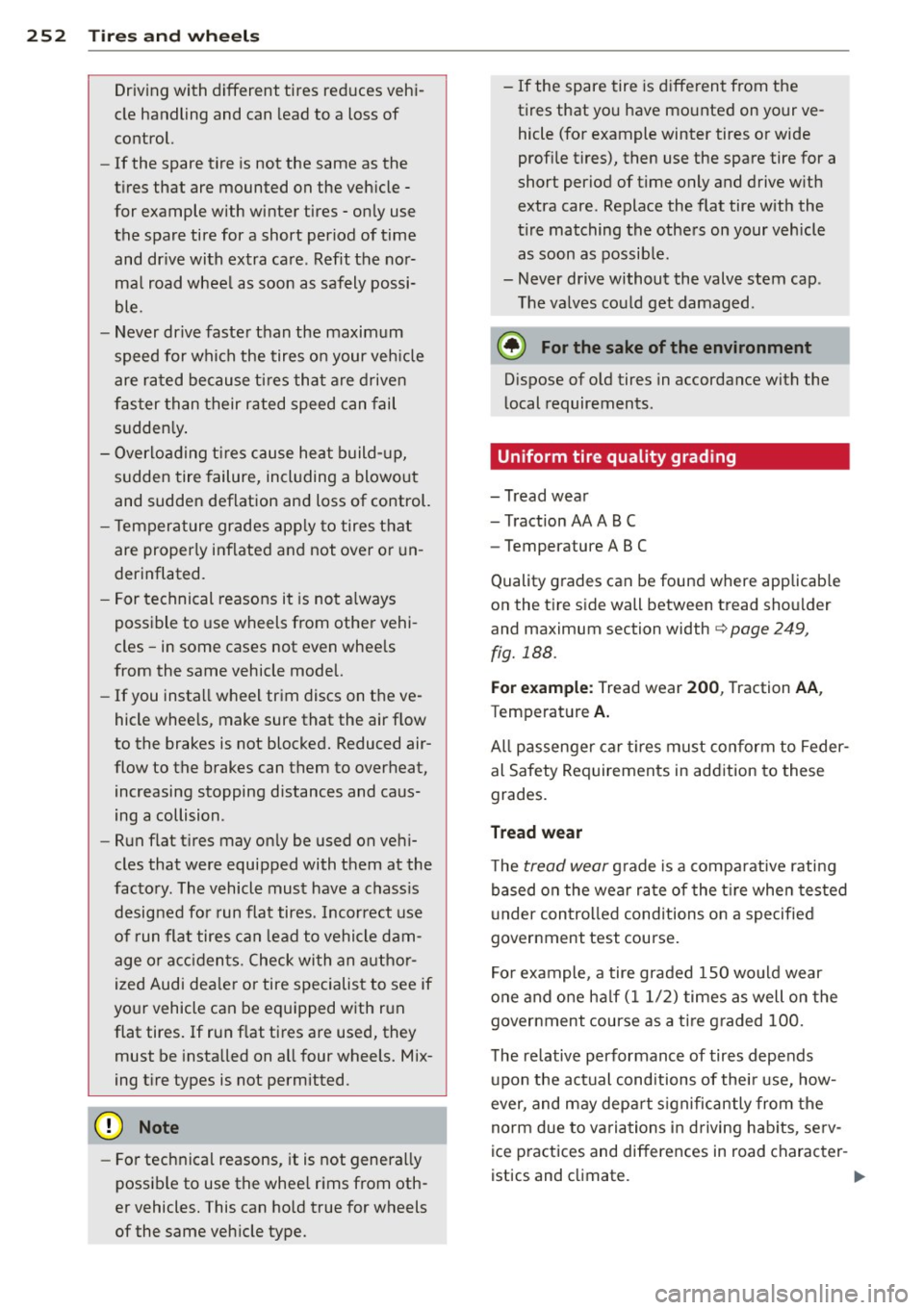
252 Tir es and whe els
Driving with different tires reduces vehi
cle handling and can lead to a loss of
control.
- If the spare tire is not the same as the
tires that are mounted on the veh icle -
for example with winter tires - only use
the spare tire for a short period of time
and dr ive with extra care . Refit the nor
ma l road wheel as soon as safely possi
ble.
- Never drive faster than the maximum
speed for which the tires on your veh icle
are rated because ti res that a re driven
faster than their rated speed can fail
sudden ly .
- Overloading t ires cause heat build- up,
sudden tire failure, including a blowout
and sudden deflation and loss of control.
- T emperature grades app ly to tires that
are properly inflated and not over o r un
derinflated .
- For technical reasons it is not a lways
possible to use wheels from other vehi
cles -in some cases not even whee ls
from the same vehicle model.
- If you install wheel trim discs on the ve
hicle whee ls, make sure that the air f low
to the brakes is not blocked. Reduced air
flow to the brakes can them to overheat, increasing stopping distances and caus
ing a collision .
- Run flat t ires may only be used on vehi
cles that were equipped with them at the
factory . The vehicle must have a chassis
designed for run flat tires . Incorrect use
of run flat tires can lead to vehicle dam
age or acc idents. Check with an a uthor
ized Audi dea le r or tire specialist to see if
yo ur vehicle can be equipped with run
flat tires. If run f lat tires are used, they
must be insta lled on all four wheels. Mix
ing t ire types is not permitted .
- Fo r technical reasons , it is not genera lly
possib le to use the whee l rims from oth
er vehicles. This can ho ld true for wheels
of the same veh icle type. - If the spare tire is different from the
tires that yo u have mounted on your ve
hicle (for example winter tires or wide
profile tires), then use the spare tire for a
short period of time only and drive w ith
extra care. Replace the flat tire w ith the
tire matching the others on your vehicle
as soon as possib le .
- Never drive without the valve stern cap .
The valves cou ld get damaged .
@) For the sake of the environment
Dispose of o ld tires in accordance with the
local requirements .
Uniform tire quality grading
-Tread wear
- Traction AA AB C
- Tempe ra tu re ABC
Quality grades can be found whe re applicab le
on the tire sid e wall betw een tr ead shou ld er
a nd maximum section width
c> page 249,
fig. 188 .
For ex ample: Tread wear 200 , Tract ion AA ,
Temperatur e A.
All passenger car t ires must conform to Feder
al Safety Requirements in add ition to these
grades.
Tread wear
T he tread wear grade is a comparative rating
based on the wear rate of the t ire when tes ted
u nder contro lled cond itions on a specified
government test course .
For example, a tire graded 150 would wear
one and one ha lf (11/2) times as well on the
government course as a tire graded 100.
T he relative performance of tires depends
upon the actual conditions of thei r use, how
ever, and may depa rt s ignificantly from the
norm due to va riations in driving hab its, se rv
ice practices and differences in road character -
istics and cl imat e. ..,.
Page 255 of 302
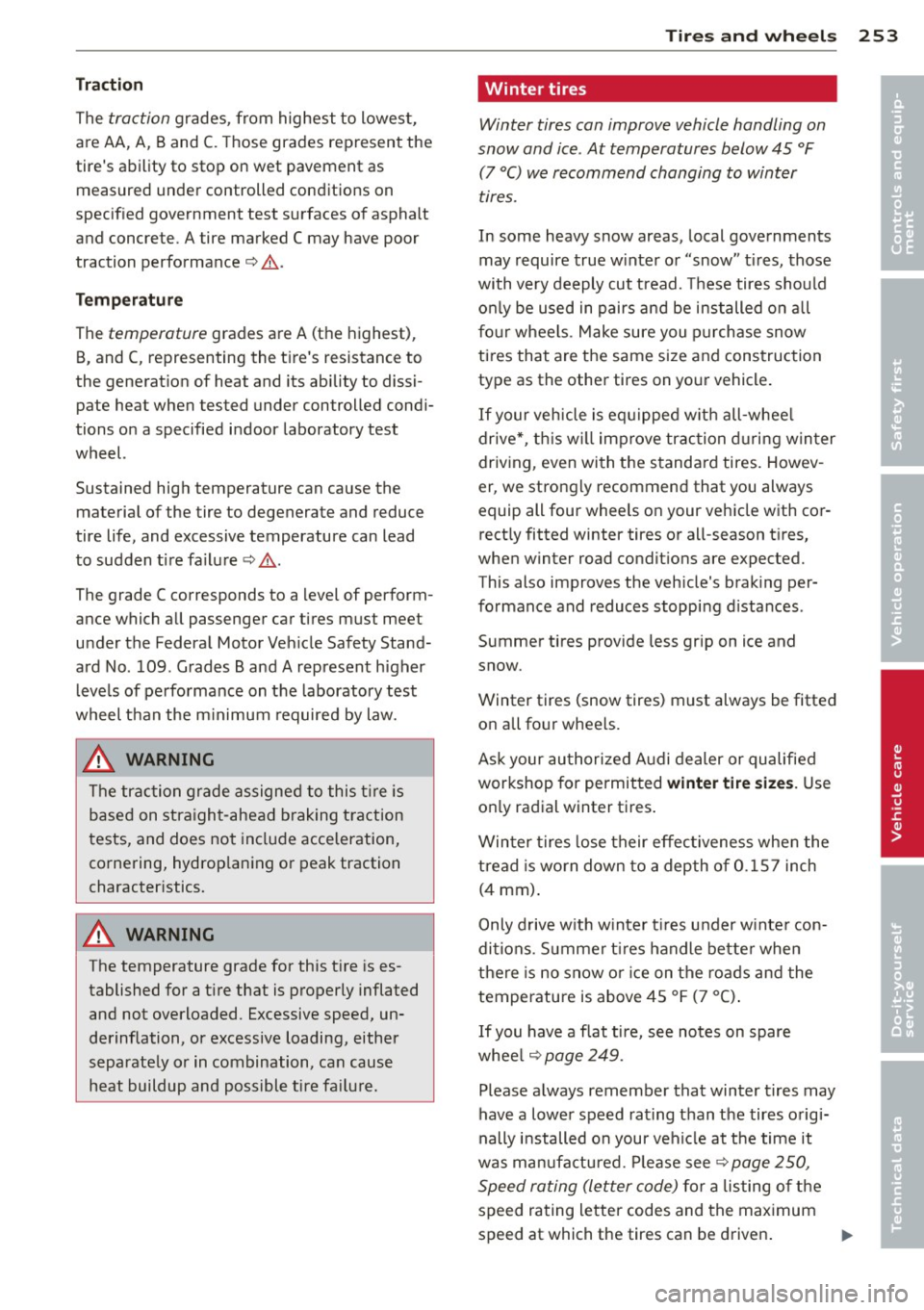
Traction
The traction grades, from highest to lowest,
a re AA, A, Band
C. Those grades represent the
tire's ability to stop on wet pavement as
measured under controlled conditions on
specified government test surfaces of asphalt
and concrete . A tire marked C may have poor
traction performance¢ .&..
Te mp era tu re
The temperature grades are A (the h ighest),
B, and
C, representing the tire 's resistance to
the generat ion of heat and its ability to dissi
pate heat when tested under controlled condi
tions on a specified indoor laboratory test
wheel.
Sustained high temperature can cause the
material of the tire to degenerate and reduce
tire life, and excessive temperature can lead
to sudden tire failure ¢.&. .
The grade C corresponds to a level of perform
ance which all passenger car tires must meet
under the Federal Motor Veh icle Safety Stand
ard No. 109. Grades Band A represent higher
leve ls of performance on the laboratory test
wheel than the m inimum required by law.
_& WARNING
T he traction grade assigned to this t ire is
based on straight-ahead b raking t raction
tests, and does not include acceleration, cornering, hydrop laning or peak traction
character istics.
A WARNING
The temperature grade for this t ire is es
tablished for a t ire that is properly inflated
and not overloaded. Excessive speed, un
derinflation, or excessive loading, either
separately or in combination, can cause
heat buildup and possible tire fa ilure.
-
Tire s an d wheel s 253
Winter tires
Winter tires can improve vehicle handling on
snow and ice . At temperatures below 45 °F
(7 °C) we recommend changing to winter
tires.
In some heavy snow areas, local gove rnments
may require true w inter o r "snow" t ires, those
with very deeply cut t read. These tires should
o nl y be used in pairs and be installed o n all
f o ur wheels . Make sure you p urchase snow
tires that are the same size and cons truction
type as the other tires on yo ur vehicle .
If your veh icle is equipped w ith all-whee l
drive *, th is w ill improve trac tion d uring win ter
driv ing, even with the s tanda rd tires. Howev
er, we strongly recommend that you always
equip all four whee ls on your veh icle w ith cor
rect ly fitted winter tires or all-season t ires,
when winter road conditions are expected.
This also improves the veh icle 's b rak ing per
formance and reduces stoppi ng d ista nces .
Summer tires provide less grip on ice and
snow.
Winter tires (snow tires) must always be fitted
on all fo ur whee ls .
As k your au thori zed A udi dealer or qualified
workshop for permit ted
winter ti re size s. Use
on ly radial winter tires .
Win ter tires lose their effec tiveness whe n the
tread is worn down to a depth o f 0.1 57 inch
(4 mm) .
Only d rive w ith w inte r tir es under w inte r con
di tions. S umme r tir es handle bette r when
t h e re is no snow o r ice on the ro ads and the
temperature is above 45 °F (7 °C) .
If you have a flat t ire, see notes on spare
whee l¢
page 249.
Please a lways remember that winter tires may
have a lowe r speed rating than the tires o rigi
nally i nstalled on your veh icle at the time it
was ma nufactu red. P lease see¢
page 250,
Speed rating (letter code)
for a lis ting o f th e
speed rating letter codes and the max imum
speed at which the tires can be driven .
111>-
•
•
Page 256 of 302

254 Tir es and whe els
The s peed ra ting le tter code( ¢ page 24 0) is
on the side wall of the tire¢ page
249.
A WARNING
Winter tires have maximum s peed limits
that may be lower t han your vehicle's max
imum speed . Always know the maximum
speed before driving off . Never drive faster
than the speed permitted for your specific
w inter t ires. This will cause damage to the
tires leading to an accident and serious
pe rsonal inj ury to you and your passen
gers .
A WARNING I>=
Driving faster than the maximum speed
for which the winter tires on your vehicle
were designed can cause tire fai lure in
cluding a blowout and sudden deflat ion,
loss of control, crashes and serious per
sonal injuries. Have worn or damaged tires
rep laced immed iate ly .
- Winter tires have maximum speed rat ing
that may be lower than your veh icle's
maximum speed .
- Never drive faster than the speed for
w hich the winter or other tires installed
on your vehicle are rated.
A WARNING
Always adjust your d rivi ng to the road and
tr affic conditions. Neve r let the good ac
celeration of the wi nte r t ir es and all-whee l
dr ive temp t you in to taking extr a ris ks . A l
ways remember :
- Whe n bra ki ng , an a ll-wheel d rive vehicle
hand les in the s ame way as a front drive
vehicle.
- Drive caref ully and reduce your speed on
icy and slippery roads, even winter tires
cannot he lp under black ice conditions.
@) For the sake of the environment
Use summe r ti res when weathe r cond i
tions perm it. They are quieter, do not we ar
as quickly and red uce fue l consumption.
Snow chains
S now cha ins may be fitted only to the front
whee ls, and o nly to cer tain ti re si zes . As k your
a uthorized Aud i dea ler on whi ch tire sizes
snow chains can be used.
If you a re go ing to use snow cha ins, then you
mus t install t hem on the front whee ls a t
l east.
T he snow chains must have low-p rofile links
and mus t not be t hicker than 0.4 inch
(10,S mm) , in cl ud ing t he loc k.
Remove whee l center cove rs and trim discs
before putt ing snow chains on your vehicle
¢ (!) . For safety reasons cove r caps must then
be fi tted over the wheel bo lts. These are ava il
able from authorized Aud i dea lers .
A WARNING
=
Using the wrong snow chains for your vehi -
cle or insta lling them incorrect ly can in
crease the risk of loss of contro l leading to
serious pe rsonal injury.
- Snow chains are available in different
sizes . Always make sure to follow the in
structions prov ided by the snow chain
manufacturer .
- W hen driving with snow cha ins never
drive faster than the speed permitted for
your specific snow chains.
- Always observe local regulations.
(D Note
- Remove snow chains before dr iving on
roads not covered with snow to avoid
damaging tires and wearing the snow
chains down unnecessarily .
- Snow chains, which come into direct con
tact with the whee l rim, ca n scratch or
damage it. Therefore, make sure that the
snow chains are s uitably covered. Check
the pos ition of the snow chains afte r
dr iving a few yards and co rrect if necces
sary. Follow the inst ruct io ns from the
snow chain m an uf actur er when do ing so.
- If the Ada ptive Ai r Suspe nsio n should
m alfu nction, do not mount o r use snow
11-